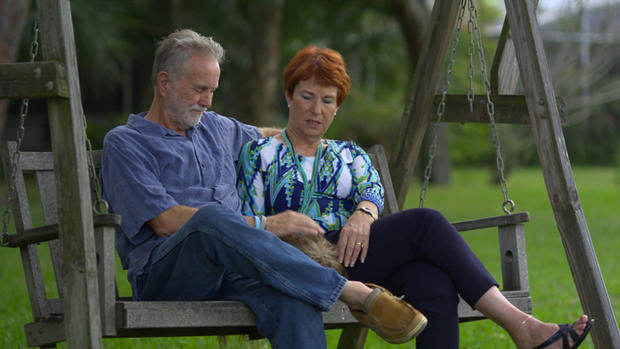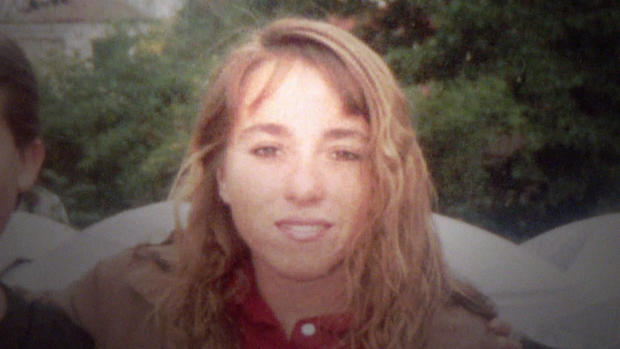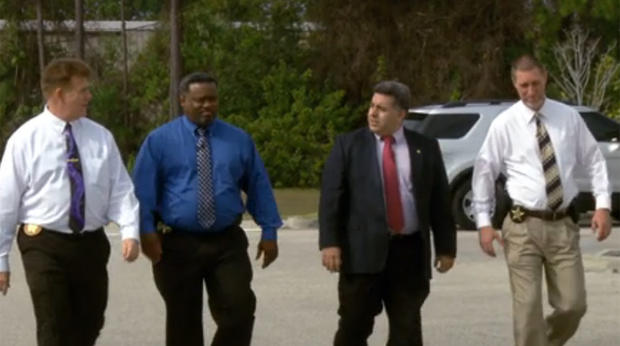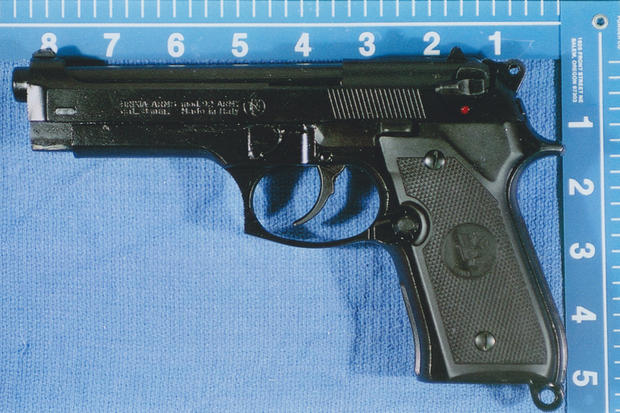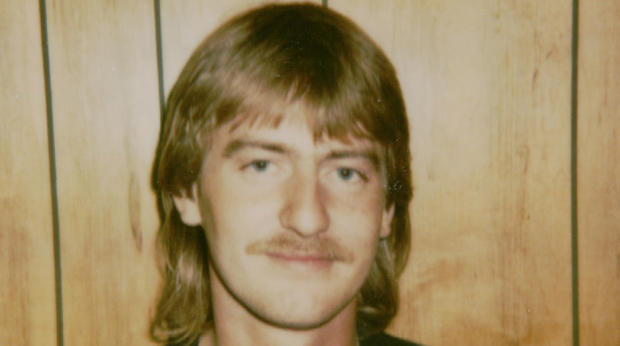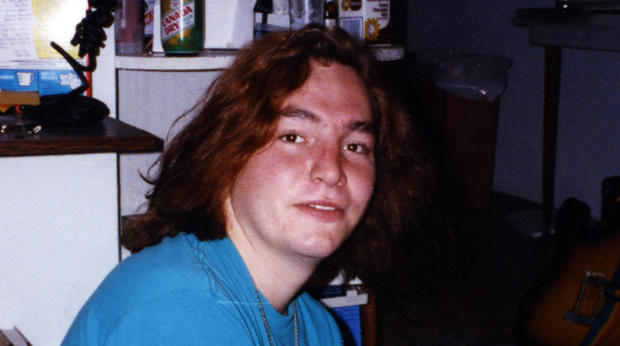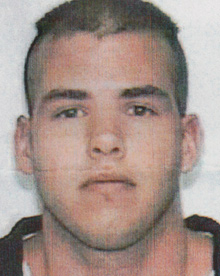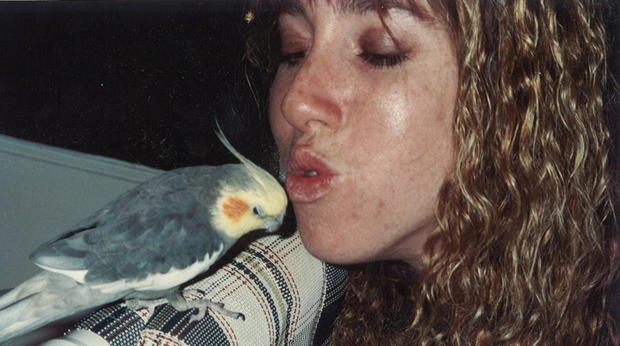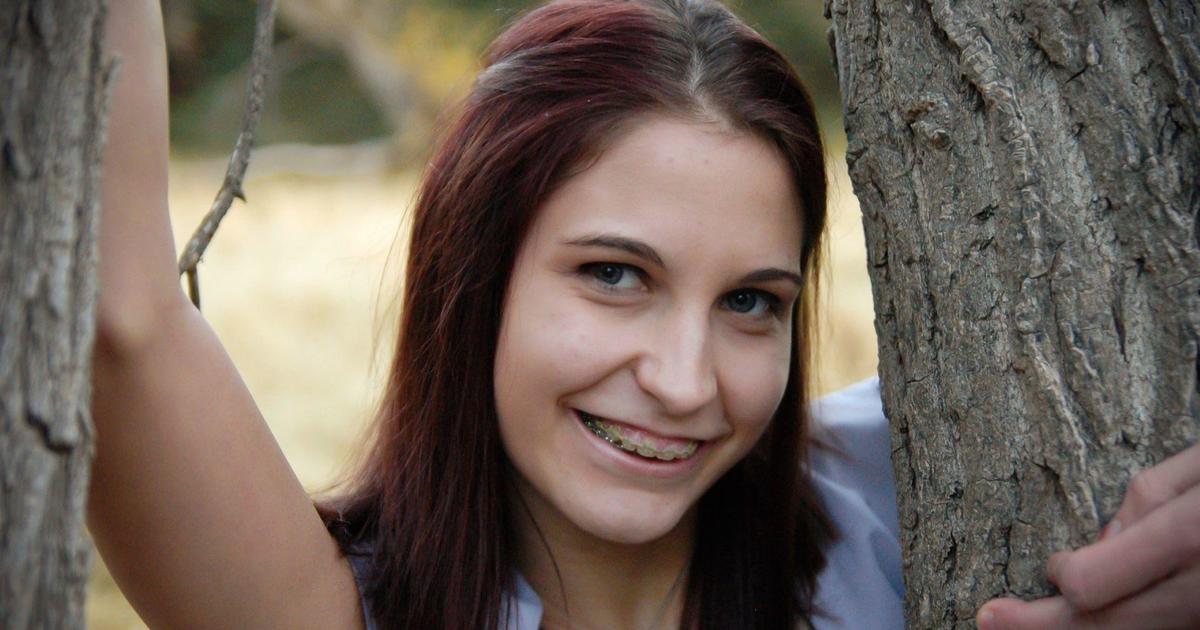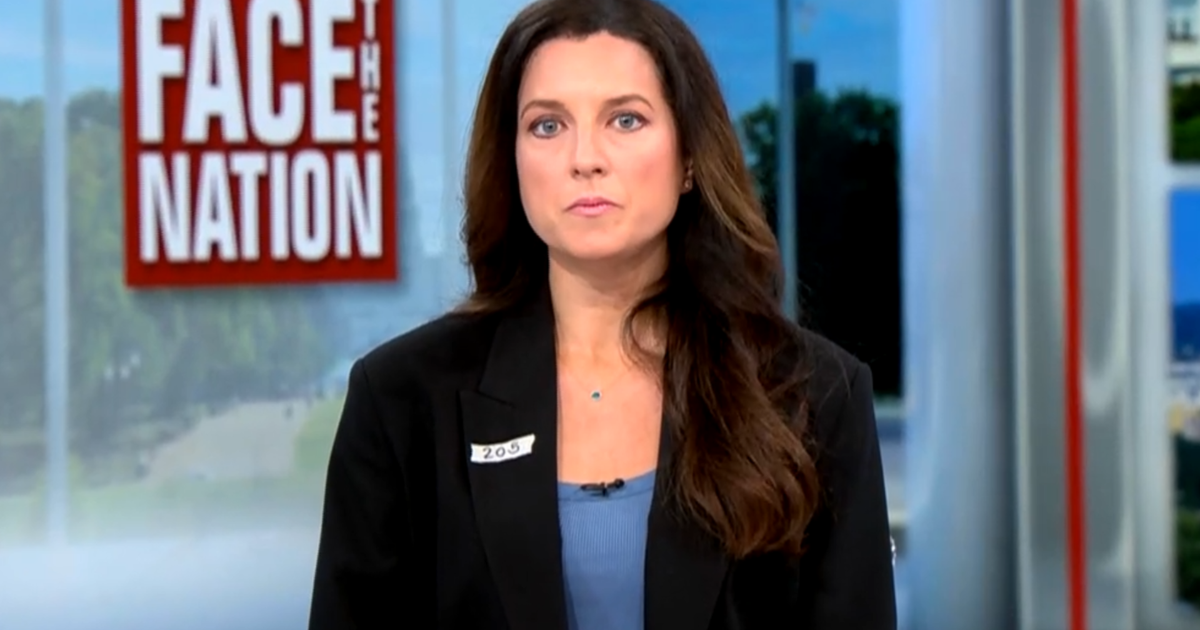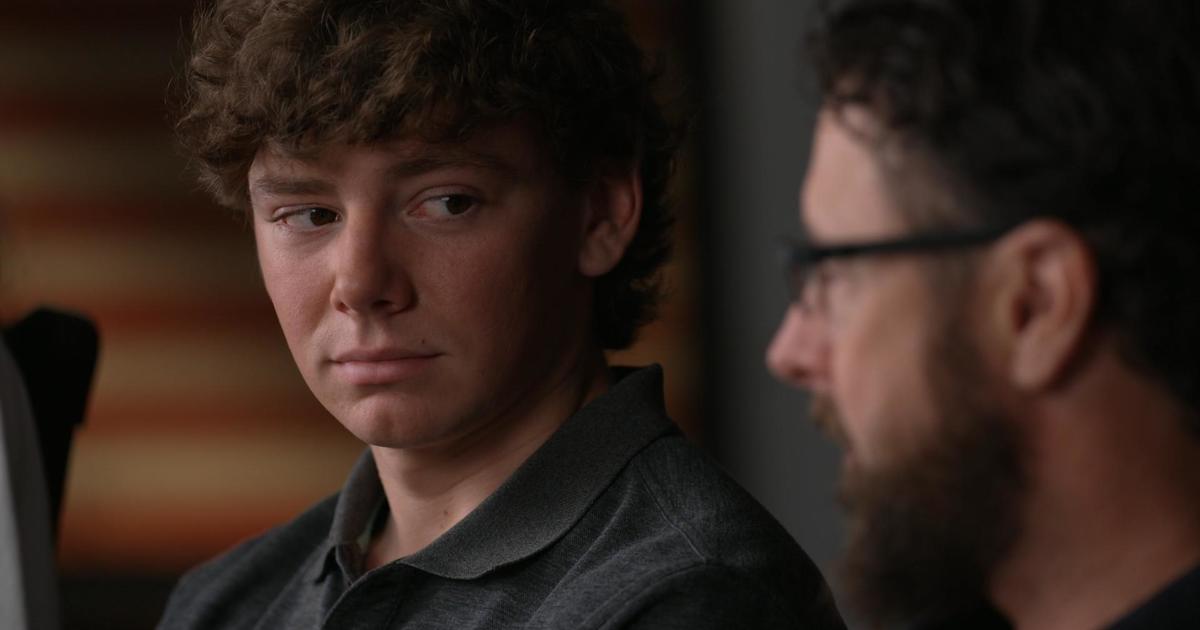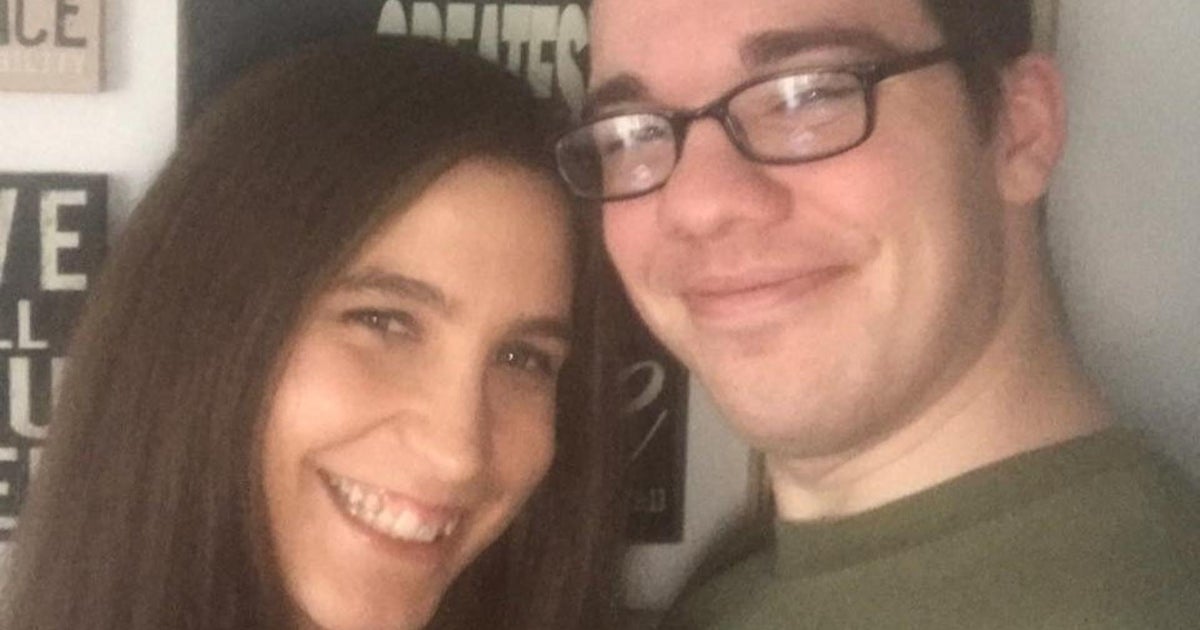Who killed Amy Gellert?
Produced by Lisa Freed
[This story first aired on March 14, 2015. It was updated on June 17, 2017]
You could help solve a cold case. Investigators need more evidence and it could come from you. Maybe you know some of the suspects or maybe you'll just notice a vital clue to this brutal murder that investigators somehow missed.
There's no day more difficult for Bunny Lehton than March 20, the anniversary of her daughter's murder.
"... just a bad day all the way around," she told "48 hours" correspondent Erin Moriarty. "I always think about tomorrow ... life will be better."
Bunny Lehton hasn't let fear force her out of her home, but continues to grieve along with her husband, Bob, and her two sons - Amy's older brothers, Mark and Ryan.
"It just doesn't end, man. It keeps on going," said Mark Gellert.
"It's been tough," Ryan Geller said. "...and I think it's just changed us all profoundly as a family and individually."
"It's hard to think about her, isn't it?" Moriarty asked.
"Yeah, it's--" Ryan Gellert said, choking up.
It's even harder to think about the events of the night of March 20, 1994.
"I see Amy at church. And she says, 'I'll be home soon,'" Bunny Lehton said. "We go home and we're early."
Bunny and Bob Lehton returned from church to find a masked intruder in their Cocoa Beach, Florida, home.
"I see the man step into the room. And he's completely disguised," Bunny Lehton told Moriarty. "And then I saw that he had -- a dagger and a gun."
The couple was forced by the intruder to crawl on their hands and knees from the kitchen to the living room. While they lay on the floor, the Lehtons say, the intruder began pacing.
"I sensed, and Bob sensed, that he was waiting for a ride," said Bunny Lehton.
She says everything changed after "...I saw the lights coming down the driveway."
"And I saw the lights coming down the driveway," Bunny Lehton continued, "He panicked ... something switched in him and he just lost it."
Startled by the headlights outside, the intruder began brutally stabbing the couple.
"First he slices me across here," Bunny Lehton said, pointing to her neck. Then, pointing to her lower back, "He stabbed me in -- here."
"As soon as the lights hit, man, he came down with the knife in the back of my head as hard as he could," Bob Lehton said. "If I don't get to the front door and start screaming, no one was gonna get out of that house alive."
It wasn't until police arrived and Bunny Lehton got to the hospital that she heard the terrible news: she and Bob had survived their wounds, but Amy had not.
Back in 1994, Tod Goodyear, of the Brevard County Sheriff's Office, was one of the investigators called to the crime scene.
"You've got a -- a well-respected family ... that is living in -- in a nice house in a quiet area. And all of a sudden, somebody breaks in ... something sets him off," he explained. "He starts to stab them and it's a blitz attack."
Goodyear says when Amy's stepfather ran out to get help, his attacker followed. Bob Lehton didn't see Amy standing by her car, but the intruder did.
"He turns his attention to Amy and goes to attack her," said Goodyear.
The slash marks on Amy's backpack indicate a struggle with her killer.
"Amy actually runs across the street toward -- an apartment complex. And she actually collapses in that parking lot and dies," said Goodyear.
"When you first started on this case ... did you think it would be solved right away?" Moriarty asked Goodyear.
"Probably the prevailing view when we first got it is, 'we're gonna figure out real quickly what the motive is and it's gonna lead us to a person and we're gonna find that person and they're gonna confess and we're gonna be done,'" Goodyear recalled.
But more than 20 years later, Major Goodyear was still trying to solve Amy Gellert's murder.
"There was a lot of ... pressure put on to solve it and ... a lotta people were -- were upset about it and still are, to this day," he said. "...the biggest problem I think we have is really trying to figure out why it happened."
"48 Hours" asked Goodyear and his cold case team - Lt. Carlos Reyes, and Agents Marlon Buggs and Wayne Simock - to explain one of the most baffling cases they've ever encountered.
"I've never worked a case like this, with this many possibilities that have been out there," said Agent Simock.
THE WEAPONS
This is what investigators do know: the intruder was armed with an unusual gun and a knife.
"He's not cursing and he's not screaming at us," Bunny Lehton said. "And then all of a sudden he's ... just stabbing the living daylights outta me."
"And he starts stabbing me in my neck. And it's going in so deep. I can feel the bones crunching," she continued. " ...to this day, 20 years later, I can hear those bones crunch ."
The Lehtons say the knife was a dagger. Because the intruder was holding it, all they could see was the ornate hilt.
"And that was very unusual, 'cause it was a gold chain that was basically, you know, interwound or twisted together," Bob Lehton explained.
The dagger has never been found.
"And have you ever been able to find one that seemed to match?" Moriarty asked Goodyear.
"Not with a hilt like that, no," he replied. "We always have to put out a thing. 'The knife may not look exactly like that.' But if someone knows of somebody that has one like that, that would be real important."
As for the gun, it turned out not to be a lethal weapon at all. Investigators were able to identify it when a magazine was found at the scene. It's actually a prop made by Brixia that fires blanks and is used in the theater and movies.
"It sure looks real," Moriarty commented to Goodyear.
"If you had that put in your face, you'd believe it was a gun," he concurred.
"But isn't that a good clue?" Moriarty asked the investigators, who were gathered for a roundtable discussion of the case.
"You would think it would be," said Lt. Reyes.
"Everybody goes, 'Oh, Cocoa Beach Theater,' boom, here we -- well, this is gonna be solved. And then you go there, 'Oh no, we're not missin' one.' ...no reports of anyone stealin' a gun like that,'" Goodyear said of the prop gun. "So that yeah, that ended up being pretty much, you know, for us -- a dead end at the time, which was very deflating."
THE INTRUDER
MALE | DRESSED IN BLACK | SKI MASK | GLOVES
Bob and Bunny Lehton were interviewed by investigators 12 days after being attacked. It was all recorded on videotape.
"He had a black ski mask on... " Bob Lehton told investigators.
"He had on a black top, black pants, white tennis shoes and those gloves that have leather on the hands," Bunny Lehton added.
A black ski mask and gloves - all are items that would not be easy to obtain in Cocoa Beach, Florida, during spring break - when the attack took place.
"If you were gonna kill them, you don't need the mask, 'cause they're not gonna be able to identify you anyway," Goodyear said. "So is it someone they knew? Or was it somebody from the area that somebody might recognize if they saw them?"
CHARACTERISTICS: AVERAGE HEIGHT | MEDIUM BUILD | CAUCASIAN
The Lehtons couldn't identify their assailant, but they could remember a few features.
"He was Caucasian. I think I picked that up on the contrast between the ski mask and his eyes," said Bob Lehton.
He was in his 20s, which would put him in his 40s now.
"Did the voice seem familiar in any way, that you had ever heard it before?" Moriarty asked.
Bunny Lehton shook her head "no," but says what she was struck by was his accent.
"I was very familiar with, you know, Maryland, Pennsylvania, kinda area, because that's what he sounded like to me," she said.
Another clue: the intruder forced Bunny and Bob to lie on the ground.
"I'm told to lay over him like this..." Bunny Lehton demonstrated, lying on her stomach across the small of the investigator's back.
"When he put me on my -- my stomach ... I could not move, I was--stuck," said Bob Lehton.
Investigators say it's a technique used to control captives and suggests the intruder may have had some kind of military training.
"Or police background?" Moriarty asked.
"Police background. Could've gone to an academy. Could've been a security guard," said Goodyear.
As for forensic evidence, DNA was found on the gun's magazine, but it may not be from the intruder.
"Part of the problem you have is we know the intruder was wearing gloves," Moriarty noted to Goodyear. "So if there's DNA, it could belong to whoever handed him -- that item."
"Correct," he replied. "Could be, or someone that had owned the item beforehand or someone that had used it with them."
But the biggest question looming for investigators is why?
"Does anybody know at this table why that intruder came into the home on March 20, 1994?" Moriarty asked the investigators.
"Specific motive? No," Reyes replied.
"And without answering that question, it makes it really tough to -- to get to the right person," said Goodyear.
They all agree the evidence points to a targeted attack. Could it be money?
"How many of you believe that the purpose of this was a burglary? Moriarty asked the investigators. No hands were raised.
"Oh, you're not sure?" said Moriarty.
"No," said one of the investigators.
While the house is near the beach and one of the nicest on the block, investigators say that a burglar would have just stolen property and fled; this intruder stayed. Stranger still, the Lehtons say, money seemed almost an afterthought to him. He took just a small amount of cash and some credit cards.
And the intruder seemed even less interested in valuables.
"They had offered money. They had offered cars. They made all these offerings just to kinda get rid of him," said Buggs.
"My wife had over $5,000 worth of jewelry on right in front of him," Bob Lehton told police.
Then investigators wondered if Bunny and Bob - both therapists -- had been targeted by an angry patient. But there was little evidence to support that.
"If you're gonna hurt the couple that's there, why wait?" Simock asked. "Why not take care of business ahead of time and then leave? ...why does he wait until Amy shows up?"
And that leaves Amy.
"Do you think, then, Amy was a target or the reason why that intruder was in the house?" Moriarty asked Reyes.
"Today, I do," he said. "This case is ongoing. It keeps developing. ...So ask me again in six months, I might have a different answer."
WHY AMY?
"I have a hard time thinking this is a random act," Major Tod Goodyear said. "The consensus tends to be that -- that Amy's the catalyst. There's something there with Amy ... that probably caused this to happen."
What was it about Amy Gellert that would make her the target? At the time of her murder, she had just turned 21.
"And what were you thinking on that birthday?" Moriarty asked Bunny Lehton.
"She's happy. We're happy. This is good," she replied.
Amy's whole life seemed ahead of her.
She was living at home with her mother and stepfather. Passionate about music, Amy got a job at the church her parents attended, working as a sound engineer in Calvary Chapel's recording studio.
"She had always wanted to be -- a roadie for a rock and roll band. And God's sense of humor, she ended up bein' a roadie for the Calvary Chapel's rock and roll Christian praise band," Bunny Lehton chuckled.
"Did you think all the problems were over?" Moriarty asked. "All behind you?"
"Yeah. I did," Bunny Lehton replied. "I did."
Amy had been though a lot in her 21 years.
She was 3 when her parents divorced. Amy and her two older brothers lived with their mother in Cocoa Beach, Florida.
"And how close were Mark, Ryan and Amy?" Moriarty asked.
"They were thick as thieves. There wasn't anything they didn't share," Bunny Lehton said as she looked at photos of her children. "And they stayed that way - always."
"She was just an incredibly good person," said Ryan Gellert.
Amy's brother, Ryan, says whatever he and brother Mark did, she wanted to do -- even skydiving.
Asked if she was gutsy, Ryan said yes. Asked if she was feisty, he told Moriarty "[She] could be ... She had a lot of life in her. ...Kind of the perfect friend, perfect sister."
Amy was 5 when her mom married Bob Lehton. Then, not long after, her life changed when she became seriously ill with encephalitis that left her with learning disabilities.
"Oh, she struggled so much," Bunny Lehton said. "And she was held back a year. And that changed a lotta things in her life."
By her freshman year in high school, she met Andrea O'Dell. They became best friends.
"She was the most special person I've ever met," O'Dell said. "She had-- an essence about her; a presence about her."
Amy was also a typical teenager, rebelling against her mom.
"Bunny wanted kind of a girly girl, and Amy was not a girly girl. And I think Amy kinda wanted to flaunt any rebelliousness in her mother's face -- and to push it, even," said O'Dell.
And like so many of her classmates, Amy was experimenting with drugs.
"She was smokin' pot," said O'Dell.
"A lot?" Moriarty asked.
"I'd say more than was healthy," O'Dell replied.
"She was not a weekend warrior, somebody who just smokes some dope on the weekends. She was somebody who would sell her soul for pot," Bunny Lehton said. "And that's how she got in trouble."
Bunny put Amy in a tough controversial rehab program in Orlando, known as "Straight."
"It was no swimming pool, nice lounge kind of drug rehab," Bunny Lehton explained.
"She didn't go to rehab by choice," said Ryan Gellert.
"She blamed your mother?" Moriarty asked.
"Oh yeah. Yeah," he replied.
In 1992, Amy returned home, seemingly a new person.
Asked if she has changed at all, O'Dell told Moriarty, "She still seemed like Amy. ...But she had a better head on her shoulders, definitely."
"It refocused her. And had her start thinking about ... what she wanted to do thereafter," said Ryan Gellert.
She had a new group of friends from church.
"I think they were really good influences on her. And I think she actually really enjoyed them," said Ryan.
In the days leading up to Amy's murder in March of 1994, spring break crowds were descending up and down the Florida coast. Ryan Gellert was also home from college.
"Overall, what I remember from that week is her being in a pretty good state of mind, and doing -- and just seemingly doing as well as I'd seen her do in a really long time," he said.
Sometime after 7:30 p.m. on the night of the murder, Amy headed to church, where she saw her parents for the last time.
"There was no premonition that anything was wrong," Bunny Lehton said. "Nothing like that."
"I get a phone call," Mark Gellert explained. "Said that ... my sister had been murdered. That my parents were in the hospital. It didn't look too good."
"My first thought was I just couldn't believe it," Ryan Gellert said, fighting back tears. "It just didn't make sense."
And 20 years later, with the investigators renewed focus on the case, the family hopes to finally have some answers.
"I think it's solvable," said Agent Marlon Buggs. "I just think that it's gonna take the -- the right piece of evidence-- and the right person to ... be willin' to talk about it."
A FRESH LOOK AT A COLD CASE
"I mean, when this happened in Cocoa Beach ... people were numb. They -- they couldn't believe it," said Bunny Lehton.
"I remember there was a lot of press from it," Buggs said. "It was on the news.
When 21-year-old Amy Gellert was brutally murdered in March of 1994, Marlon Buggs was the same age and a cadet at the police academy.
"So to hear about someone being stabbed to death and this big murder scene ... That was a big deal," he said.
It never occurred to him that more than 20 years later, he'd be asked to use fresh eyes to finally solve the case that has stymied so many of his colleagues.
"I read through this case on a daily basis," Buggs told Moriarty. "I run it by my partners. It's a discussion at lunch that we have. ... This case, there's so many questions."
And over the years, so many suspects.
"There's a lot," said Buggs.
"Most cases, you may have one primary suspect, maybe a couple peripheral suspects. But in this one, there's many possibilities," said Lt. Carlos Reyes.
Like Jeffrey Anderson, a burglar currently in prison. He was involved in a police chase the day after Amy Gellert was murdered. When he was caught, he was in a stolen car. Later, when Bunny Lehton's credit cards were found on the side of the road in the vicinity, he became a suspect.
"... passed a polygraph, wasn't picked out in a voice lineup," Goodyear said. "You can't totally say 100 percent ... But you feel more - more likely than not, he wouldn't be the guy."
And police couldn't link him to those credit cards.
And there was Hugh Poppell. At one time, he had a romantic relationship with Amy. He didn't become a suspect until 2013 - almost 19 years after the crime -- when a tip came in to Crimeline.
"Hugh Poppell had been killed in a hit-and-run accident," Simock explained. "And there was a comment made ... that it was karma for what he had done to Amy Gellert."
While there's no physical evidence connecting him to Amy's murder, Poppell remains on the list of suspects.
And there are others much higher on Buggs' list that he and Simock want to track down and re-interview.
"That's Dominic Kanuika ... his name keeps poppin' up," Buggs said as Moriarty held up Kanuika's photo.
Around the time of Amy's death, Dominic Kanuika, a 22-year-old short order cook from Pennsylvania, had recently moved to Cocoa Beach with his high school girlfriend, Julie Flounders.
But investigators didn't learn about Kanuika until a year later, when they got a tip from someone who worked with Flounders.
"She overheard Dominic's girlfriend sayin' that he was possibly involved with that homicide," said Buggs.
Investigators then learned Kanuika had stolen a car and left the area the day after Amy's murder. He later moved back to Pennsylvania, where investigators tracked him down. And he told them a startling story.
"Dominic ... puts himself at the scene," said Buggs.
Kanuika claimed that he was coming from home work when he drove past Amy's house.
"He sees all the, you know, lights and the cop cars and the fire trucks. And he actually stops, pulls over, and walks up to see what was goin' on," Buggs continued.
"He was just bein' a concerned citizen, just happened to be drivin' by there, stops and assists the deputy in putting up the crime scene tape ... which is, I'm not sayin' it's impossible. But I'm sayin' it's unheard of," said Reyes.
And his story didn't check out when investigators went to the restaurant where Kanuika worked.
"They pulled his time card from Gatsby's and he didn't work that night," said Buggs.
Suddenly, they had another person on their list.
"That kinda put him ... as a very important person of interest at that time," said Reyes.
And Kanuika kept looking better and better.
"He had just moved down here from Pennsylvania, only been in the area for maybe a couple months at the most," said Buggs.
So Kanuika would be one of the few people in Cocoa Beach who could have cold weather gear, like masks and gloves.
"And, so, I believe he had those items with him," said Buggs.
And coming from Pennsylvania, he had that Mid-Atlantic accent that Amy's mom described hearing.
"I was very familiar with, you know, Maryland, Pennsylvania kinda area, because that's what he sounded like to me," Bunny Lehton said.
For reasons that aren't clear, a voice lineup was never done. Kanuika was given a polygraph and failed it.
Still, investigators couldn't connect Kanuika either to Amy Gellert or her murder. They couldn't find any mutual friends and there wasn't any physical evidence that put him inside the house. And so, he trail went cold until 2014.
Now the new team - Agents Marlon Buggs and Wayne Simock -- are retracing steps made by earlier investigators, and have gone to Pennsylvania hoping to re-question Dominic Kanuika.
"It's hard to get your hopes up, right, that you might have the right suspect 'cause there have been other suspects in the past that looked -- really good in this case," said Moriarty.
"Oh yeah," said Buggs.
"They have been," said Simock.
"But this, right now, is probably the strongest one," said Buggs.
But before they take their chances with Kanuika, they decide to make a surprise stop at the home of that old girlfriend who allegedly had been overheard talking about Kanuika's involvement in Amy's murder: Julie Flounders.
"I'm hoping she's been waiting to get this off her chest, and when we show up at the door, that's her opportunity," said Buggs.
Originally she denied saying it, but Agent Buggs hopes that Flounders, now married with children, may have additional information that will help.
"So we wanted to take a shot at her," he said.
Much to their surprise, she invites them in and is more than willing to talk about Kanuika.
"How did Julie describe him? Didn't she describe him as crazy?" Moriarty asked.
"She said he could go both--Nice guy, not a nice guy," said Simock.
"He could go both ways," said Buggs.
"That fits this intruder," said Moriarty.
"Oh, absolutely," said Simock.
Kanuika's also a convicted thief.
"When you talk about the thievery part of it, would Dominic steal from somebody or break into a home, 'Well, on that case, yeah,'" said Buggs.
"She also did say that he -- he had a propensity to have knives," Simock added.
And there's his military training.
"Dominic Kanuika was in the Marine Corp boot camp just previous to this, and you know, one of the things he learned how to do was fight with a knife," said Buggs.
But unfortunately, after two decades, Flounders' memories about that specific March night have faded.
"The key information I needed from her she couldn't remember," said Buggs.
When first questioned, Kanuika told investigators he was driving Flounders' Jeep on the night of the murder.
"... she can't remember if he had the Jeep or not," said Buggs.
And said he'd told Flounders about being at the crime scene.
"Did she remember him saying that he had been at the scene of a horrific murder?" Moriarty asked Buggs.
"That -- that, she doesn't remember," he replied.
And what about her comment that her boyfriend may have been involved in Amy Gellert's murder? For years, Julie Flounder denied saying it. But she told these investigators that she might have said it in jest. But still denies Kanuika ever confessed to murder.
"48 Hours" also wanted to talk with Flounders - and she agreed to sit down and tell Moriarty what she knew about Kanuika back in Cocoa Beach in 1994. But in the end, all we got was an empty chair. Julie Flounders says she's too afraid of him.
The next stop is 280 miles away in Marienville, Pennsylvania, where Dominic Kanuika is serving time for drug possession and robbery.
"At the moment we still don't know - how's he going to receive us. What's he gonna say," Simock said. "We just got some high hopes right now, that he's going to talk to us."
LIES UNCOVERED
There's a lot riding on the trip to Marienville, Pennsylvania. Agents Wayne Simock and Marlon Buggs need to convince Dominic Kanuika to talk about Amy Gellert's murder.
"You don't wanna say the wrong thing, you don't want him to shut down. So-- yeah, I got some butterflies," Simock said as he drove towards the prison.
"Might be our last shot at ... an opportunity to talk to him," said Buggs.
As it turns out, Kanuika agrees to talk, but he has nothing new to say.
"He had this strange confidence about him," Buggs explained. "He still puts himself at the scene. ...But he continues to claim that he has no involvement. ...He says, 'How could I do that?' He says, 'I'm just an addict.'"
Kanuika is now in prison for robbing a pharmacy.
"As long as we let him just ramble on about what he wanted to tell us -- he was real comfortable. When we started askin' questions about -- the case-- he got real defensive," said Buggs.
After three hours, the investigators head home to Florida disappointed.
"You know, it'd be great to come here and -- and try to clear this up, but right now," Simock said standing outside the prison. "I think we're leaving with more questions than answers."
But they are not through with Kanuika yet. They wonder if he may be somehow connected to the man who has topped their suspect list for more than 20 years.
"Who is the number one suspect?" Moriarty asked the investigators.
"That's Scott Manley," said Buggs, referring to a 1994 photo.
Scott Manley, a friend of Amy Gellert's, became a suspect within hours of her murder.
"When you start lookin' for that motive, you know, you start thinkin', you know, who had access to her home? Scott Manley," said Buggs.
On the evening of March 20, Manley stopped by Amy's house.
"Scott Manley was probably the last one of her friends to be in her home," said Buggs.
Manley told police he had plans to go out with Amy later that night after she got home from church, but he never made it. He left this message on her answering machine just 30 minutes after she had been stabbed to death:
Scott Manley's message: Gellert, it's Scott. It's like 9:30. It's too late to go out. I'll give you a ring about later this week. See ya.
"We all like to say there's no coincidence in homicide investigation," Major Tod Goodyear said. "You know, it's kinda strange. All of a sudden just after she's killed there's a phone message from him sayin,' 'Hey -- it's too late to go out.' ... There's a lot of things that make him very interesting."
By all accounts, Scott Manley was a handsome bad boy.
"People describe him even back then as a con artist," said Buggs.
And a serious cocaine addict. Amy met him in rehab. Two-and-a-half years older, he was also from Cocoa Beach, and when they both left the "Straight" program, they tried to stay clean.
"I don't think he was successful. He was still -- a drug addict," said Buggs.
There were more attempts at rehab in New Jersey and Pennsylvania. When he returned home in the fall of 1993, Manley started using crack cocaine again. He also reconnected with Amy, which greatly concerned her brother, Ryan.
"I knew Scott wasn't a great influence for her," Ryan Gellert said. "That wasn't a relationship I was very happy about."
"Was she completely clean when she returned back to -" Moriarty asked Amy's best friend, Andrea O'Dell.
"No ... She was smoking pot again," she replied. "I knew that she had some people from 'Straight' that she was -- was getting it from."
As investigators discovered, Amy felt caught between two worlds: her new friends at church and the wilder crowd she once hung out with in Cocoa Beach.
"Well, I think she was tryin' to make good for herself. It's almost like the angel and -- and the devil on each side. You know, one side pullin' her one way and one side pullin' her the other way," said Simock.
Just days before she was killed, Amy asked her brother, Ryan, to drive with her to the apartment complex where Manley lived with his parents.
"She needed to get something from him," Ryan Gellert said. "The whole thing just didn't make me feel very comfortable. ...Why is she hanging out with this guy? Why is she asking me to go over there and do this? What's going on here? This just doesn't feel -- right."
Agent Buggs wonders if Amy brought her brother because she was afraid of Manley.
"She has friends that say that Scott actually owed her money because they put their money together to purchase drugs," he said. "And even Scott Manley himself talks about owin' Amy money."
The morning after Amy was killed, Manley showed up at the Cocoa Beach police station to explain why he left that phone message cancelling his date with Amy.
"At the time it really was no reason to suspect anything," said Buggs.
But the more Manley talked, the more lies investigators uncovered. He told them the reason he stopped by Amy's house was to pay her back $30. His father not only drove him there, he gave Manley the cash. But it wasn't the whole story.
"Later on, he admits that he pocketed the money, that he didn't give the money to Amy -- that it was a ploy," said Buggs.
It was a scam to get money from his father to buy drugs. Manley says he then spent the evening alone driving around, smoking crack cocaine. And then there was Manley's claim that he and Amy were going out that night. But Andrea O'Dell, disputes that.
"We had plans the night she died. We had plans to go for a walk on the beach," she said.
"Does it make sense ... that she would've said something to Scott, that she would also meet him later?" Moriarty asked O'Dell.
"No," she replied.
"He continually lies. Everything's a lie," said Buggs.
Still, Manley claimed to have an alibi: he said he was home before 9 p.m. and his parents backed him. What's more, none of Amy or her parents' blood was found in Manley's car.
"If that had been Scott and he stabbed somebody, wouldn't there-- had to be blood in that car?" Moriarty asked.
"You would think so," said Lt. Reyes.
And photos of his hands show no signs of a struggle.
"You say you can't get Scott Manley out of your head. Why has he never been arrested?" Moriarty asked Buggs.
"There's no hardcore evidence that we can just link to Scott Manley. So that -- that makes it difficult," he replied.
Manley couldn't stay out of trouble. In 1995, after another failed rehab in Colorado, he was accused of kidnapping his girlfriend's young child -- all to get money for drugs. Brevard County investigators traveled there in 1996 to question him about Amy Gellert's murder.
Scott Manley to investigators: It hurts me to think that I'm even, you know, that I'm even considered to know something you know.
He agreed to take a polygraph:
Question: Regarding the death of Amy Gellert, do you know for sure who stabbed her?
Scott Manley: No.
Question: Did you participate in planning a burglary in Amy Gellert's house that eventually led to her death?
Scott Manley: No
"And, you know, he doesn't do so well on it. But then again, he keeps changin' the story," said Buggs.
In fact, Manley failed the polygraph. By 2005, he was in trouble again -- this time in Florida for robbery.
He remains on the list of possible suspects.
"There's somethin' that I feel that he's connected with this somehow, whether he told somebody the layout of the house or the fact that Amy's parents weren't home -- the fact that she comes from money--" said Buggs.
Now these investigators are wondering if perhaps Manley had help -- an accomplice -- which brings them back to Dominic Kanuika. On the night Amy was killed, Manley said he was driving around looking to buy crack cocaine from a white guy with a northern accent named Nick. Could Nick be Dominic?
"WE KNOW THIS CASE IS SOLVABLE"
In the more than 20 years that investigators have struggled to find Amy Gellert's killer, two names keep coming up.
"I keep comin' back to Scott Manley and Dominic Kanuika," said Agent Buggs.
One theory is that both men were involved. Did Amy have something they wanted? Money or drugs?
"What if Scott came across Dominic at some point and talked Dominic into doin' this? They're both havin' this addiction to drugs. They're both needin' money," said Buggs.
Remember, Dominic Kanuika places himself at the scene and investigators have wondered if the plan was for Kanuika to break into the house while Scott Manley drove the getaway car.
"Did Dominic get dropped off by Scott Manley and then Scott was gonna circle around and pick him back up?" Buggs asked.
When Bunny and Bob Lehton came home from church early, the plan may have fallen apart. Could Manley have abandoned Kanuika -- leaving him in the lurch? That would fit with the Lehton's description of the masked intruder.
"He seemed nervous," Bunny Lehton said. "He was just pacing the room."
"He acted like he was waiting for a ride, that the person had left him high and dry and he was waiting for that person to come back," said Bob Lehton.
Each man denies knowing the other - but investigators uncovered a possible link: Gatsby's restaurant, where Dominic Kanuika worked as a cook. And it's where Scott Manley, according to his dad, had a job interview. They eventually tracked down a waitress there who identified Manley's photo.
"She picked Scott Manley out as bein' someone she thought came in ... looking for Dominic at one point," said Buggs.
"That's the closest connection you can make between these two men?" Moriarty asked.
"As of right now, yes," said one of the investigators.
And then there's Scott Manley's own admission to police - that the night of the murder he was looking for a drug dealer named Nick. But Kanuika's former girlfriend, Julie Flounders, says that Dominic went by the nickname Dom, not Nick.
"48 Hours" reached out to Scott Manley and he agreed to an interview - but as we were heading to the prison where he was being held on that robbery charge, he suddenly backed out.
"48 Hours" does have letters that Manley wrote to us saying "please, please find whoever is responsible" for Amy's death." But it's what he didn't say that caught the investigators attention.
"He never really denies involvement," said Major Tod Goodyear.
"48 Hours" asked Major Goodyear to look at Manley's letters with an analysis technique used by law enforcement.
"You can't file charges on Scott Manley based on anything in these letters. How does it help?" Moriarty asked.
"Well, it's an investigative tool," Goodyear replied.
Manley writes: "the fact that anyone thought it possible that I could be a part of such a horrible crime nauseated me."
"Most people would say, 'I find it reprehensible, I find it unbelievable that anyone thinks -- that I could kill her," said Goodyear.
"I-- I'd commit this," said Moriarty.
"'Cause I didn't." That would be a very strong statement that says, "I didn't do it," Goodyear continued.
"And instead?"
"And -- this is not an 'I didn't do it.' This is a, 'I can't believe anybody thinks I could be a part of this,'" said Goodyear.
Goodyear is also intrigued by the line that Manley and Amy "planned to go out when she returned home from church..."
"Which to me it kinda signifies they were going to go out on some kind of a social or semi date," Goodyear said. "And then later on in the letter he talks about he was supposed to go there for a meeting."
"Had I not cancelled our meeting, could I have helped or saved Amy?"
"That word 'meeting' means something to you, because it could lead to motive," Moriarty noted.
"Could," Goodyear said. "Because a 'meeting' is business."
That's why Goodyear wonders if that "meeting" involved drugs.
"I've always thought that he was involved," said Bunny Lehton.
But suspicion isn't enough. DNA found on the gun's magazine doesn't match Scott Manley, Dominic Kanuika or any other known suspect.
"It's still a track," Bugg explained. "So if it's not one of our suspects, but it's somebody that was linked to them, it's still a good thing."
"Is Dominic Kanuika still a suspect?"Moriarty asked Goodyear.
"I would say, yeah, he's still a suspect 'cause we can't clear him out," he replied.
"And Scott Manley is still a suspect?"
"Uh-huh," Goodyear affirmed. "We can't connect him definitively to it. And then again, we can't clear him."
Investigators concede Amy Gellert's killer could be someone not even on their radar. There's no statute of limitations for murder, so they hope scientific technology -- or some new tip -- will be key to solving this case.
"In cases like this, anything could be important," Goodyear stressed.
"We know this case is solvable. ...I think that people are holding onto information. ...they don't think it's significant. But it is. It means everything to us. ...Amy means everything to us," Bunny Lehton said. "I'm not into vengeance, I'm into justice. I want justice to be served."
DO YOU HAVE INFORMATION ABOUT AMY GELLERT'S MURDER?
Anyone with information is asked to contact:
- Phone: (321) 633-8413
- Email: majorcrimes@bcso.us
- 1-800-423-TIPS | 1-800-423-8477
- You can remain anonymous
